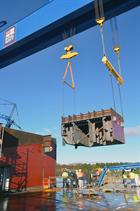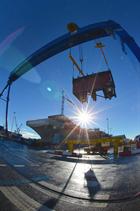Queen Elizabeth carrier hull complete
The final piece of the gigantic jigsaw that is the Royal Navy’s future carrier HMS Queen Elizabeth is in place with her ski ramp completed. Only the aircraft lifts and radar need to be added to complete outward construction of the 65,000-tonne leviathan in Rosyth.
The hull of the carrier is now complete after the last section of her ‘ski ramp’, which will help F35 Lightning IIs get airborne off the expansive flight deck, was fitted at Rosyth dockyard.
Under the watchful eye of shipyard workers, the Goliath crane which dominates the north shore of the Forth, gently manoeuvred the very front part of the aircraft ramp into place.
With the addition of the 130-tonne section, the finished ramp stands more than six metres (20ft) high, although at 300 tonnes the completed structure weighs less than half a per cent of the total displacement of Queen Elizabeth: 65,000 tonnes.
Its installation signals the end of an important chapter in the construction of the nation’s flagships. Only the aircraft lifts and the radar remain to be lifted into place by Goliath.
“This event means a pivotal chapter in the delivery of HMS Queen Elizabeth has been completed. The ship here in the dock is a truly magnificent sight,”
said Ian Booth, programme director of the Aircraft Carrier Alliance, the coalition of MOD, Royal Navy and industry which is building Queen Elizabeth and her sister Prince of Wales.
“Everyone involved in the programme to deliver HMS Queen Elizabeth should feel tremendously proud of what we have all achieved to get to this point.
“Thousands of men and women across the country have worked together as one team in a remarkable demonstration of British skills and capabilities.”
As well as 10,000 people across the country involved in the construction of the two carriers, Queen Elizabeth has a 50-strong ship’s company who are helping her introduction into service, writing her ‘instruction manual’.
“It’s a complete privilege to be involved,”
said head of weapon engineering Cdr Steve Lynn
“I get excited about what’s happening next week, let alone next year.
“My guys love it. They get to be involved, they get their hands on things which they’d not normally do, and they’ve got the chance to influence the ship and how she operates.
“The important thing about this ship is that she’ll be flying the flag one day, flying jets the next. She’ll be at the heart of the UK’s defence for the next 50 years.”
The carrier is due to be ‘launched’ – she’ll actually be flooded up, with water being allowed into the dry dock where she’s being constructed for the first time – next summer.
She’s earmarked to begin sea trials in the autumn of 2016 and make her first appearance in her future home of Portsmouth in late 2016 or early 2017.
F35s will be making use of the ski ramp for the first time the following year, with the carrier ready for operations around 2020.







